The role of oligomerization and cooperative regulation in protein function: the case of tryptophan synthase
- PMID: 21085641
- PMCID: PMC2978696
- DOI: 10.1371/journal.pcbi.1000994
The role of oligomerization and cooperative regulation in protein function: the case of tryptophan synthase
Abstract
The oligomerization/co-localization of protein complexes and their cooperative regulation in protein function is a key feature in many biological systems. The synergistic regulation in different subunits often enhances the functional properties of the multi-enzyme complex. The present study used molecular dynamics and Brownian dynamics simulations to study the effects of allostery, oligomerization and intermediate channeling on enhancing the protein function of tryptophan synthase (TRPS). TRPS uses a set of α/β-dimeric units to catalyze the last two steps of L-tryptophan biosynthesis, and the rate is remarkably slower in the isolated monomers. Our work shows that without their binding partner, the isolated monomers are stable and more rigid. The substrates can form fairly stable interactions with the protein in both forms when the protein reaches the final ligand-bound conformations. Our simulations also revealed that the α/β-dimeric unit stabilizes the substrate-protein conformation in the ligand binding process, which lowers the conformation transition barrier and helps the protein conformations shift from an open/inactive form to a closed/active form. Brownian dynamics simulations with a coarse-grained model illustrate how protein conformations affect substrate channeling. The results highlight the complex roles of protein oligomerization and the fine balance between rigidity and dynamics in protein function.
Conflict of interest statement
The authors have declared that no competing interests exist.
Figures
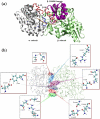



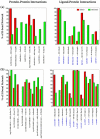
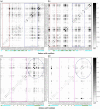
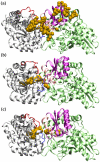
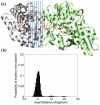
Similar articles
-
Tryptophan synthase: the workings of a channeling nanomachine.Trends Biochem Sci. 2008 Jun;33(6):254-64. doi: 10.1016/j.tibs.2008.04.008. Epub 2008 May 15. Trends Biochem Sci. 2008. PMID: 18486479 Review.
-
Allostery and substrate channeling in the tryptophan synthase bienzyme complex: evidence for two subunit conformations and four quaternary states.Biochemistry. 2013 Sep 17;52(37):6396-411. doi: 10.1021/bi400795e. Epub 2013 Sep 6. Biochemistry. 2013. PMID: 23952479 Free PMC article.
-
Synergistic regulation and ligand-induced conformational changes of tryptophan synthase.Biochemistry. 2009 Oct 20;48(41):9921-31. doi: 10.1021/bi901358j. Biochemistry. 2009. PMID: 19764814
-
Tryptophan synthase: structure and function of the monovalent cation site.Biochemistry. 2009 Nov 24;48(46):10997-1010. doi: 10.1021/bi9008374. Biochemistry. 2009. PMID: 19848417 Free PMC article.
-
Protein architecture, dynamics and allostery in tryptophan synthase channeling.Trends Biochem Sci. 1997 Jan;22(1):22-7. doi: 10.1016/s0968-0004(96)10066-9. Trends Biochem Sci. 1997. PMID: 9020588 Review.
Cited by
-
Modeling cellular compartmentation in one-carbon metabolism.Wiley Interdiscip Rev Syst Biol Med. 2013 May-Jun;5(3):343-65. doi: 10.1002/wsbm.1209. Epub 2013 Feb 13. Wiley Interdiscip Rev Syst Biol Med. 2013. PMID: 23408533 Free PMC article. Review.
-
Engineered control of enzyme structural dynamics and function.Protein Sci. 2018 Apr;27(4):825-838. doi: 10.1002/pro.3379. Epub 2018 Feb 16. Protein Sci. 2018. PMID: 29380452 Free PMC article. Review.
-
Severing of a hydrogen bond disrupts amino acid networks in the catalytically active state of the alpha subunit of tryptophan synthase.Protein Sci. 2015 Apr;24(4):484-94. doi: 10.1002/pro.2598. Epub 2014 Dec 11. Protein Sci. 2015. PMID: 25377949 Free PMC article.
-
Human and viral Golgi anti-apoptotic proteins (GAAPs) oligomerize via different mechanisms and monomeric GAAP inhibits apoptosis and modulates calcium.J Biol Chem. 2013 May 3;288(18):13057-67. doi: 10.1074/jbc.M112.414367. Epub 2013 Mar 18. J Biol Chem. 2013. PMID: 23508950 Free PMC article.
-
Structural Basis for Allostery in PLP-dependent Enzymes.Front Mol Biosci. 2022 Apr 25;9:884281. doi: 10.3389/fmolb.2022.884281. eCollection 2022. Front Mol Biosci. 2022. PMID: 35547395 Free PMC article. Review.
References
-
- Woolf PJ, Linderman JJ. Self organization of membrane proteins via dimerization. Biophys Chem. 2003;104:217–227. - PubMed
-
- Marianayagam NJ, Sunde M, Matthews JM. The power of two: protein dimerization in biology. Trends Biochem Sci. 2004;29:618–625. - PubMed
-
- Meng GY, Fronzes R, Chandran V, Remaut H, Waksman G. Protein oligomerization in the bacterial outer membrane. Mol Membr Biol. 2009;26:136–145. - PubMed
-
- Ali MH, Imperiali B. Protein oligomerization: How and why. Bioorgan Med Chem. 2005;13:5013–5020. - PubMed
-
- Brinda KV, Vishveshwara S. Oligomeric protein structure networks: insights into protein-protein interactions. BMC Bioinformatics. 2005;6 doi: 10.1186/1471-2105-6-296. - DOI - PMC - PubMed
Publication types
MeSH terms
Substances
LinkOut - more resources
Full Text Sources

